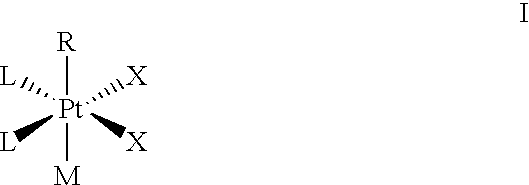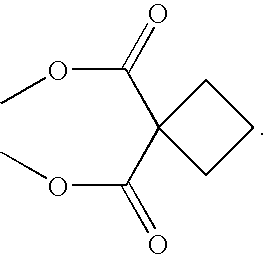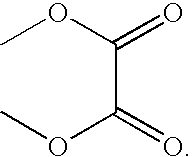Coordination complexes having tethered therapeutic agents and/or targeting moieties, and methods of making and using the same
a technology of coordination complexes and therapeutic agents, applied in the direction of peptides, drug compositions, peptides, etc., can solve the problems of preventing dna replication, affecting the replication rate of dna, and unable to solve the disease definitively,
- Summary
- Abstract
- Description
- Claims
- Application Information
AI Technical Summary
Benefits of technology
Problems solved by technology
Method used
Image
Examples
example 1
[0400]Synthesis of cis, cis, trans-(NH3)2Pt(OH)2Cl2 To a 0.57 g (1.89 mmol) portion of cisplatin was added 20.3 mL 30% H2O2 (v / v). The obtained brownish slurry was stirred for 2 hours at 55° C. then cool down to −10° C. for one hour. The obtained brownish solid filtered out and dried in the lypholizer overnight. Yield=58.4% (369 mg). I.R. (KBr): 3514 cm−1.
example 2
[0401]Synthesis of cis, cis, trans-Diamminedichlorodisuccinatoplatinum(IV) (2) Succinic anhydride (4.1 g, 41 mmol) and cis, cis, trans-diamminedichlorodihydroxyplatinum(IV) (3.3 g, 10 mmol) were dissolved in 5 mL of DMSO. The solution was heated to 70° C. for 15 h with constant stirring, cooled to room temperature, filtered, and the DMSO was removed from the filtrate by lyophilization to yield a yellow solid. Recrystallization from acetone at −20° C. afforded a pale yellow powder (3.7 g, 6.9 mmol, 69% yield). 1H NMR (d6-acetone, 300 MHz): δ 2.45 (m, 4H, CH2), 2.53 (m, 4H, CH2), 6.511 (broad singlet, 6H, NH3). 195Pt NMR: δ(195Pt) 1226.531 ppm. ESI-MS: [M+H]=534.0004 amu (calculated); 534.0001 amu (observed).
example 3
[0402]Synthesis of 3-tert-butoxycarbonylaminopropionic acid (L2). Triethylamine (6.2 mL, 45 mmol) was added to a solution of 3-aminopropionic acid (2.67 g, 30.0 mmol) in 50% aqueous dioxane (30 mL). BOC-ON (8.15 g, 33.1 mmol) was added and the reaction stirred for 3 h at room temperature. The reaction solution was diluted with H2O (40 mL) and ethyl acetate (60 mL). The aqueous layer was isolated, washed with ethyl acetate, and acidified with a 5% citric acid solution. The aqueous layer was subsequently extracted with ethyl acetate. The organic fractions were combined and evaporated to yield L2 as a cream solid (3.64 g, 62.8%). 1H NMR (d6-DMSO, 300 MHz): δ 1.35 (s, 9H, CH3), 2.33 (t, 2H, CH2), 3.11 (q, 2H, CH2), 6.67 (t, 1H, NH).
PUM
| Property | Measurement | Unit |
|---|---|---|
| pKa | aaaaa | aaaaa |
| pKa | aaaaa | aaaaa |
| chemical shifts | aaaaa | aaaaa |
Abstract
Description
Claims
Application Information
 Login to View More
Login to View More - R&D
- Intellectual Property
- Life Sciences
- Materials
- Tech Scout
- Unparalleled Data Quality
- Higher Quality Content
- 60% Fewer Hallucinations
Browse by: Latest US Patents, China's latest patents, Technical Efficacy Thesaurus, Application Domain, Technology Topic, Popular Technical Reports.
© 2025 PatSnap. All rights reserved.Legal|Privacy policy|Modern Slavery Act Transparency Statement|Sitemap|About US| Contact US: help@patsnap.com



